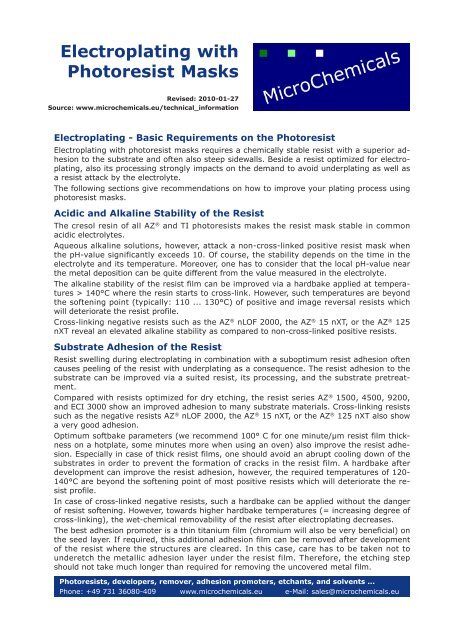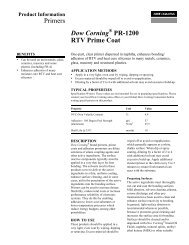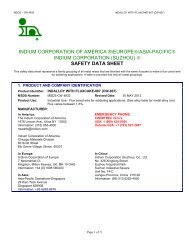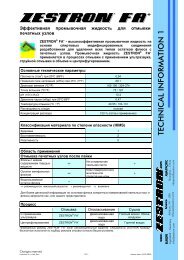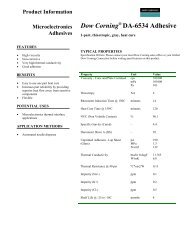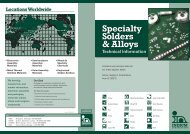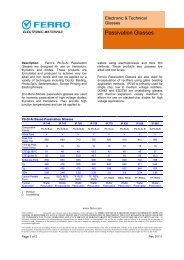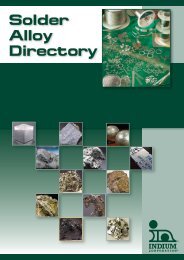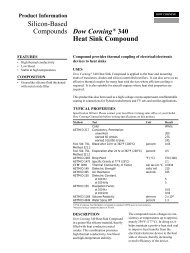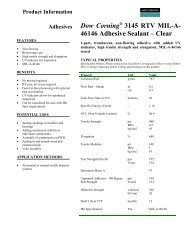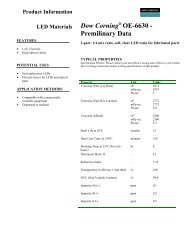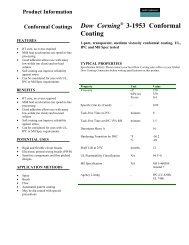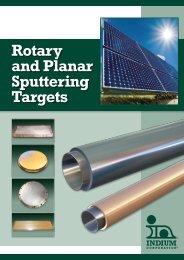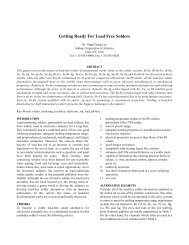Electroplating with Photoresist Masks
Electroplating with Photoresist Masks
Electroplating with Photoresist Masks
You also want an ePaper? Increase the reach of your titles
YUMPU automatically turns print PDFs into web optimized ePapers that Google loves.
<strong>Electroplating</strong> <strong>with</strong><br />
<strong>Photoresist</strong> <strong>Masks</strong><br />
Revised: 2010-01-27<br />
Source: www.microchemicals.eu/technical_information<br />
<strong>Electroplating</strong> - Basic Requirements on the <strong>Photoresist</strong><br />
<strong>Electroplating</strong> <strong>with</strong> photoresist masks requires a chemically stable resist <strong>with</strong> a superior adhesion<br />
to the substrate and often also steep sidewalls. Beside a resist optimized for electroplating,<br />
also its processing strongly impacts on the demand to avoid underplating as well as<br />
a resist attack by the electrolyte.<br />
The following sections give recommendations on how to improve your plating process using<br />
photoresist masks.<br />
Acidic and Alkaline Stability of the Resist<br />
The cresol resin of all AZ ® and TI photoresists makes the resist mask stable in common<br />
acidic electrolytes.<br />
Aqueous alkaline solutions, however, attack a non-cross-linked positive resist mask when<br />
the pH-value significantly exceeds 10. Of course, the stability depends on the time in the<br />
electrolyte and its temperature. Moreover, one has to consider that the local pH-value near<br />
the metal deposition can be quite different from the value measured in the electrolyte.<br />
The alkaline stability of the resist film can be improved via a hardbake applied at temperatures<br />
> 140°C where the resin starts to cross-link. However, such temperatures are beyond<br />
the softening point (typically: 110 ... 130°C) of positive and image reversal resists which<br />
will deteriorate the resist profile.<br />
Cross-linking negative resists such as the AZ ® nLOF 2000, the AZ ® 15 nXT, or the AZ ® 125<br />
nXT reveal an elevated alkaline stability as compared to non-cross-linked positive resists.<br />
Substrate Adhesion of the Resist<br />
Resist swelling during electroplating in combination <strong>with</strong> a suboptimum resist adhesion often<br />
causes peeling of the resist <strong>with</strong> underplating as a consequence. The resist adhesion to the<br />
substrate can be improved via a suited resist, its processing, and the substrate pretreatment.<br />
Compared <strong>with</strong> resists optimized for dry etching, the resist series AZ ® 1500, 4500, 9200,<br />
and ECI 3000 show an improved adhesion to many substrate materials. Cross-linking resists<br />
such as the negative resists AZ ® nLOF 2000, the AZ ® 15 nXT, or the AZ ® 125 nXT also show<br />
a very good adhesion.<br />
Optimum softbake parameters (we recommend 100° C for one minute/µm resist film thickness<br />
on a hotplate, some minutes more when using an oven) also improve the resist adhesion.<br />
Especially in case of thick resist films, one should avoid an abrupt cooling down of the<br />
substrates in order to prevent the formation of cracks in the resist film. A hardbake after<br />
development can improve the resist adhesion, however, the required temperatures of 120-<br />
140°C are beyond the softening point of most positive resists which will deteriorate the resist<br />
profile.<br />
In case of cross-linked negative resists, such a hardbake can be applied <strong>with</strong>out the danger<br />
of resist softening. However, towards higher hardbake temperatures (= increasing degree of<br />
cross-linking), the wet-chemical removability of the resist after electroplating decreases.<br />
The best adhesion promoter is a thin titanium film (chromium will also be very beneficial) on<br />
the seed layer. If required, this additional adhesion film can be removed after development<br />
of the resist where the structures are cleared. In this case, care has to be taken not to<br />
underetch the metallic adhesion layer under the resist film. Therefore, the etching step<br />
should not take much longer than required for removing the uncovered metal film.<br />
<strong>Photoresist</strong>s, developers, remover, adhesion promoters, etchants, and solvents ...<br />
Phone: +49 731 36080-409 www.microchemicals.eu e-Mail: sales@microchemicals.eu
MicroChemicals GmbH<br />
Contamination by Residual Solvent<br />
Typical softbake parameters keep the remaining solvent concentration in the resist film at<br />
approx. 2-4 %. If released to the electrolyte, the solvent may impact the metal deposition<br />
chemistry <strong>with</strong> a reduced deposition rate as a consequence. In this case, a longer softbake<br />
and/or elevated softbake temperatures are recommended.<br />
Thick resist films will have a comparable high solvent concentration especially near the substrate<br />
even after a prolonged softbake. In this case, a baking step after development at<br />
temperatures of approx. 10°C below the resist softening point would be beneficial.<br />
Cross-linked negative resists do not soften during a hardbake. However, towards higher<br />
baking temperatures, the degree of cross-linking increases making the resist film less removable<br />
after electroplating.<br />
Resist Profile<br />
If steep resist sidewalls are required, we recommend the positive AZ ® ECI 3000 or AZ ®<br />
6600 series for film thicknesses < 5 µm, or the positive resists AZ ® 4562 or AZ ® 9260, or<br />
the negative resist AZ ® 15 nXT, for 5-30 µm resist film thickness. If very thick resist films<br />
are required, the negative resist AZ ® 125 nXT allows steep sidewalls in the range 30-150<br />
µm resist film thickness.<br />
If required, a positive profile of the deposited metal structures requires a negative resist<br />
profile. This can easily be obtained <strong>with</strong> the negative AZ ® nLOF 2000 or AZ ® 15 nXT resists<br />
for thicknesses of 5 ... 30 µm, or the AZ ® 125 nXT for films up to 100 µm and even higher.<br />
These resists allow an adjustment of the undercut via the process parameters exposure<br />
dose and post exposure bake temperature.<br />
Metal Adhesion<br />
Some resists require special developers for residual-free development. If unsuitable developers<br />
are used, or the subsequent rinsing is not sufficiently applied, thin and almost invisible<br />
resist residuals may stay on the substrate (‚scumming‘) preventing a proper contact between<br />
the substrate and the deposited metal.<br />
If such residuals occur despite a sufficiently long development and rinsing, the usage of (or<br />
a 20-30 second dip after development in) the developer AZ ® 826 MIF which has a special<br />
scum remover added will be beneficial.<br />
Incorrectly applied adhesion promoter such as HMDS applied from the liquid phase may also<br />
deteriorate the contact between seed layer and deposited metal.<br />
Disclaimer of Warranty<br />
All information, process guides, recipes etc. given in this brochure have been added to the<br />
best of our knowledge. However, we cannot issue any guarantee concerning the accuracy of<br />
the information.<br />
Generally, and especially for the wet chemical etching recipes we do not guarantee the correctness<br />
of the specification of the composition, the mixing ratio, the mixing and application<br />
of the etches and solutions. The recommended sequence of the mixing of the components<br />
of each recipe does not generally correspond to the order of the components listed. Generally,<br />
it is recommended to i) add the acid to the dilutor, ii) add stronger acids to weaker acids,<br />
and iii) add the oxidizer last.<br />
We assume no liability for any hazard for staff and equipment which might stem from the<br />
information given in this brochure.<br />
Generally speaking, it is in the responsibility of every staff member to inform herself/himself<br />
about the processes to be performed in the appropriate (technical) literature, in order to<br />
minimize any risk to man or machine.<br />
<strong>Photoresist</strong>s for <strong>Electroplating</strong><br />
The following two sections introduce the two negative resists AZ ® 15 nXT and AZ ® 125 nXT.<br />
Please contact us for further information or a free sample!<br />
<strong>Photoresist</strong>s, developers, remover, adhesion promoters, etchants, and solvents ...<br />
Phone: +49 731 36080-409 www.microchemicals.eu e-Mail: sales@microchemicals.eu<br />
-2-
MicroChemicals GmbH<br />
<strong>Electroplating</strong> <strong>with</strong> the AZ ® 15 nXT Negative Resist<br />
AZ ® 15 nXT is a cross-linking negative resist for resist film thicknesses up to approx. 30 µm.<br />
The high stability and superior adhesion make the AZ ® 15 nXT well suited for most electroplating<br />
applications. The resist sidewalls are very steep up to a film thickness of approx. 10<br />
µm, towards higher resist film thicknesses the resist profiles becomes more and more negative<br />
allowing the electrodeposition of structures which narrow from bottom to top.<br />
5 ... 20 µm via single-coating<br />
Aqueous alkaline developers (such as the TMAH-based AZ 326/726/827 MIF)<br />
Excellent adhesion, no underplating<br />
Wide substrate compatibility: Cu, Au, Ti, NiFe, …<br />
Wide plating compatibility: Cu, Ni, Au, …<br />
Standard wet stripping processes<br />
Please contact us for further information, the technical data sheet, process recommendations,<br />
or a free sample!<br />
<strong>Photoresist</strong>s, developers, remover, adhesion promoters, etchants, and solvents ...<br />
Phone: +49 731 36080-409 www.microchemicals.eu e-Mail: sales@microchemicals.eu<br />
-3-
<strong>Electroplating</strong> <strong>with</strong> the AZ ® 125 nXT Negative Resist<br />
MicroChemicals GmbH<br />
AZ ® 125 nXT is a cross-linking negative resist for resist film thicknesses up to 100 µm and<br />
even more <strong>with</strong> very steep sidewalls. The high stability and superior adhesion make the AZ ®<br />
125 nXT well suited for most electroplating applications where very thick films are required.<br />
This resist requires no post exposure bake or any delays between the process steps.<br />
30 … 100 µm via single-coating<br />
Aqueous alkaline developers (such as the TMAH-based AZ 326/726/827 MIF)<br />
Excellent adhesion, no underplating<br />
No post exposure bake, no delays between process steps required<br />
Wide substrate compatibility: Cu, Au, Ti, NiFe, GaAs, …<br />
Wide plating compatibility: Cu, Ni, Au, solder …<br />
Standard wet stripping processes<br />
Please contact us for further information, the technical data sheet, process recommendations,<br />
or a free sample!<br />
The images shown in this document stem from the techical data sheets of the manufacturer AZ-EM.<br />
AZ and the AZ logo are registered trademarks of AZ Electronic Materials (Germany) GmbH.<br />
<strong>Photoresist</strong>s, developers, remover, adhesion promoters, etchants, and solvents ...<br />
Phone: +49 731 36080-409 www.microchemicals.eu e-Mail: sales@microchemicals.eu<br />
-4-


